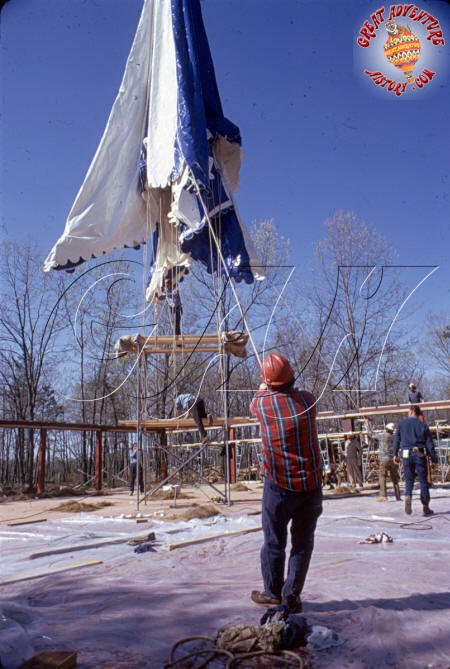 |
Originally serving as the main merchandise location at Great Adventure's
front gate on Dream Street, the four tents were originally to be five
tents. The fifth tent which was pictured in early renderings of the
Enchanted Forest was never built with the space instead becoming home to
"The Happening" trampoline show in the first two seasons of operations.
The tent structures were meant to match the fair style of the front gate
area with bright colors and fanciful wares. |
|
|
|
 |
 |
|
|
|
 |
 |
|
|
|
 |
 |
|
|
|
|
The slabs for the tents were poured concrete which was stained in colors
to match the tents. The slabs were preset with conduit for electric
wiring and with holes left for the steel support columns. Footings for
the steel columns had been poured prior to the slab floors. |
 |
|
|
|
 |
The columns for the walls were then set around the edges of the
buildings. The steel was bolted in place then the openings in the floor
were filled around them. The columns were then topped off with steel cap
plates which provided additional rigidity as well as an anchor point for
the canvas roof.
|
|
|
 |
|
|
|
 |
The center columns were raised into place with rings for fastening the
canvas looking like crows nests near the top. Once bolted in
place, the center column was also filled with concrete to make the floor
seamless. |
|
|
|
 |
 |
|
|
|
|
With all of the steel structure finished, it was time to begin attaching
the canvas roofs. |
 |
|
|
|
 |
You can see in this picture that the center ring for attaching the
canvas was designed to be moved up into place in order to stretch the
fabric tightly. The silver cone on the floor next to the corner of the
building is the metal caps which would be placed over the top to
hide the hardware as well as to protect the interior from weather. The
length of primed steel on the ground beside the tent is the flag pole
that will eventually be placed at the center of the tent. |
|
|
|
|
The canvas was then prepared for installation with ropes attached to the
center point and points around the edges. Around the ledgers wood
sheathing was attached as a fastening point for the canvas. |
 |
|
|
|
 |
 |
|
|
|
|
At the center of the blue tents a scaffolding was setup and the canvas
was lowered into place. It appears two different methods were used to
setup the canvas with the blue tent being pulled into place then the
central column being setup underneath it. |
 |
|
|
|
 |
%20copy_small.jpg) |
|
|
|
 |
 |
|
|
|
 |
With the ropes around the perimeter the canvas was stretched out to the
frame while the crane held the center up.
|
|
|
 |
|
|
|
 |
Once the canvas was stretched it was attached to the frame. The
center column was then put in place and the canvas bolted onto it. A
crane then pulled the center ring up where it was attached to the top of
the column. The workers below are ready to bolt the ring in place. |
|
|
|
 |
 |
|
|
|
The red tent canvas appears to have been placed over the center column
before being stretched to the sides. With the leaves on the trees
in these pictures it appears to have been done after the blue tent, and
we would assume with lessons learned from assembling one tent that the
technique changed.
|
 |
|
|
 |
|
|
|
|
Once the roofs were in place work began with workers placing the glass
walls and the doors to make the buildings weather tight. On the back
side of each one the stock rooms and mechanicals were placed with air
conditioning units to keep the massive structures cool. |
 |
|
|
|
 |
The finishing touch on each of the tents was the cap and flag pole.
Originally the caps were painted with stripes to match the canvas. Each
of the buildings was finished with arched window facades to dress up the
plate glass windows along the street. |
|
|
|
 |
 |
|
|
|
 |
 |
|
|
The interiors of the tents were finished with custom fixtures and unique
colorful displays created by craftsmen on site. The soaring ceilings
each featured a unique treatment that was unlike anything seen before.
The most remarkable of all was the silver tree at the center of the
yellow and white tent that would be known as Fairy Tales.
|
|
|
|
 |
The hundreds of colorful foil leafs for the silver tree were assembled
for installation on the branches.
|
|
|
 |
|
|
|
The unique circus style display fixtures were created inside the blue
and white International Bazaar tent.
|
 |
|
|
 |
|
|
|
|
With the four tents looking nearly complete, the paving Dream Street
has not yet begun at the time of this photo. Construction of the Carousel does not seem to have
started yet either. |
 |
|
|
|
 |
The construction of Great Adventure was a monumental feat, with the
buildings and rides all being worked on simultaneously around the park.
The fact that most of the projects were completed in less than six
months was a testament to the hard work of all the construction crews.
|
|
|
 |
|
|
|
|
As opening day approached, Dream Street looked ready to begin welcoming
guests into the Enchanted Forest. The four tents were stocked and ready
for the crowds that were about to arrive. |
 |
|
|
|
|
|

![]()